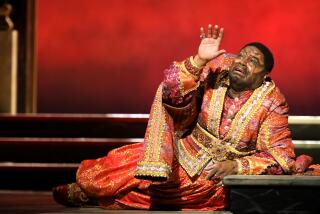Review: L.A. Opera’s ‘Moses’ finds its sonic power with the voice of the community
In 2007, Los Angeles Opera launched an outreach project that has turned into an annual tradition: The company took over the Cathedral of Our Lady of the Angels and staged Britten’s “Noah’s Flood,” which was designed by the composer to involve an entire community.
In one of his earliest acts as L.A. Opera music director, James Conlon took on the conducting himself rather than delegate it to an assistant, as he could have. Admission was free.
Lo, the show was a hit, and it has been repeated in every odd-numbered year since, with other religion-themed pieces performed during the even-numbered years. But in this odd-numbered year, L.A. Opera tried something new and different — or mostly different.
The company commissioned an Old Testament opera titled “Moses” from San Jose composer Henry Mollicone and librettist Shishir Kurup from the Cornerstone Theater Company, rounded up a cast of hundreds from a sprawling roster of community collaborators too numerous to list here, and threw it all together at the cathedral Friday night. It made an appealingly big noise in a big space, a lively biblical community shout.
PLAY WITH RAY: Winner of contest will perform onstage at the Hollywood Bowl »
The plot picks up the story of the baby Moses being plucked out of the Nile by an Egyptian princess who raises him as her own son. In this telling, his half brother Ramses becomes Pharaoah (Moses’ older brother Aaron is nowhere to be found) and banishes Moses to the desert after he kills a cruel bully. Eventually, Moses confronts Ramses and leads the Israelites out of Egypt, parts the Red Sea and endures his people’s worship of a golden calf before delivering the Ten Commandments to restore their faith
When you think of Moses operas, the ones that come to mind most frequently are Rossini’s “Mosè in Egitto” and Schoenberg’s “Moses und Aron.” Yet as Conlon said to the audience before the music started, the “Noah” production was indeed the model for this “Moses” in several ways.
Mollicone inserted three Bach-inspired chorales into the score for the congregation (a.k.a. the audience) to sing — as did Britten — and before the performance, Conlon again enthusiastically rehearsed us with a glockenspiel bonging out the melody line as a guide track. Eli Villanueva, the resident stage director for L.A. Opera’s Education and Community Engagement wing, returned to direct.
As vigorously led by Conlon, the cast, orchestra and chorus were again a mix of a few L.A. Opera pros with amateurs from Southern California. The littlest ones among them were again turned loose to run somewhat amok, dressed in costumes representing some of the 10 plagues that descended upon ancient Egypt.
As before, some waved turquoise streamers signifying a body of water — the Red Sea. The earth-toned desert sets were minimal; their angular features seemed to sprout from those of the cathedral itself. Those who were seated along the central aisle were inches away from some of the action.
SPRING ARTS PREVIEW: Critics’ recommendations and the emerging artists to know »
Granted, Mollicone’s score was leagues apart in sound and feeling from Britten’s. This was a mostly grandiose thing of Middle Eastern scales and irregular meter dances for the Israelites, some cinematic bombast, lots of attractive tunes, highly descriptive orchestration for the plague scene and even a wisp of Sprechstimme (spoken song) for the Egyptians at one point. (Was this an inside-joke reference to Schoenberg’s opera?)
The score had to fight its way to be heard through the cathedral’s notoriously long reverberation decay, with overbearing amplification doing little to clarify the ingredients of the sonic soup. Yet precisely because of its grandiosity, this 64-minute opera seemed a better fit for this acoustically cavernous room than the subtleties of Britten.
The Moses of baritone Michael J. Hawk had a commanding presence whether as a young hothead or an older, crustier figure laying down the law. Baritone Juan Carlos Heredia also boomed imposingly as Moses’ father-in-law, Jethro, and as the Voice of God in tandem with soprano Sarah Vautour (also Zipporah). Tenor Alok Kumar was an effective vocal foil as Ramses. Try as everyone did to make their English words clear in this difficult space, the supertitles were definitely needed.
“Noah” should be returning to its odd-numbered-year slot in 2021, while “Moses” is tentatively scheduled to repeat in 2022.
Support our coverage of local artists and the local arts scene by becoming a digital subscriber.
See all of our latest arts news and reviews at latimes.com/arts.
More to Read
The biggest entertainment stories
Get our big stories about Hollywood, film, television, music, arts, culture and more right in your inbox as soon as they publish.
You may occasionally receive promotional content from the Los Angeles Times.






